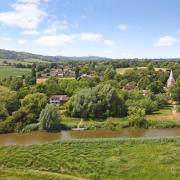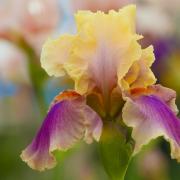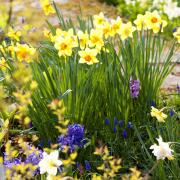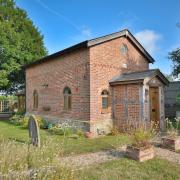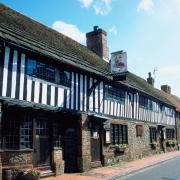The number of birds that were once common visitors in Sussex gardens are in free fall arguably because of climate change and urbanization. Even the most spotted bird – house sparrows – have declined drastically with more than 22 million believed to have disappeared from the country.
‘We are in a nature and climate emergency and we've lost 38 million birds from our skies in the last 50 years,' Beccy Speight, RSPB's chief executive said last year after the organisation’s Big Garden Birdwatch results came out.
And we can all help the organisation’s conservation efforts and come together for nature in 2024 to join in the world’s largest garden wildlife survey, which returns on 26, 27 and 28 January.
Now in its 45th year, the RSPB’s Big Garden Birdwatch gathers data from volunteers birdwatching in their gardens to paint an important snapshot of the health of our UK birds. Last year over 11,500 people took part in Sussex, and more than 9 million birds were counted across the UK. By taking time to count the birds in our gardens we can help identify which birds are in decline and how this could impact other wildlife and nature.
That’s because falling numbers of one species is an indicator that other species or habitats linked to this bird may be in trouble too; there may be fewer insects or berries to eat or less safe places to nest and climate change could be part of the cause. By feeding into the nationwide results, it helps the RSPB better target their conservation efforts. It’s also great for our wellbeing, giving us permission to grab a cuppa and take time out to connect with nature.
Winners and Losers
The RSPB Big Garden Birdwatch showed the steep decline in Song Thrush numbers, which are still down 81% compared to numbers recorded in the first survey back in1979. These were once very familiar garden birds with brown backs and spotted fronts, hopping around the lawn in search of food. You could always tell if a Song Thrush was around by the collection of broken snail shells lying on their favourite ‘anvil’, a rock they use to smash open the molluscs to get at the soft bodies inside. They also have a distinctive way of singing, repeating notes or phrases three or four times. Song Thrushes ranked at 22 in West Sussex’s 2023 results and 21 in East Sussex’s results, seen in just 10% and 13% of gardens respectively.
House Sparrows celebrated their 20th year as the number one bird spotted in UK gardens last year. But despite their top position, they have sadly suffered severe declines too, with numbers in gardens dropping by nearly 60% since 1979.
No one knows exactly why the number has decreased so drastically but some of the explanations given include increased urbanisation leading to a lack of food and suitable nesting sites, and an increase in the number of predators such as squirrels and magpies as well as climate change.
But it’s not all bad news. Last year the Big Garden Birdwatch celebrated the Long-tailed Tit, which rose five positions in the rankings with numbers 39% higher than in 2022. This species is easily recognised with its distinctive colouring, small body and a long tail, which can be up to 9cm in length. Both males and females are black, white and pale pink, with distinctive white crowns. You'll probably notice Long-tailed Tits most when they are in small, excitable flocks of about 20 birds. They love to hang from feeders full of fat balls. This species is vulnerable to harsh weather, and their numbers have fluctuated since the survey began, so let’s keep our fingers crossed for them this year.
Get Birdwatch Ready!
To get ready for your Big Garden Birdwatch start providing daily bird food and water in your garden now. It can take several weeks for feathered friends to notice that a new bird café has opened.
Birds need lots of energy to maintain their body temperature during winter, so it’s important to provide suitable high fat birdfood, including sunflower seeds, peanuts, or fat-based birdfood bars. If these foods come in a mesh sacking, remove the netting, and place the contents directly into a feeder or on a bird table – preventing birds from becoming trapped and injured in the mesh.
Fruits like apples and pears, even when past their best, will be happily snapped up by Blackbirds and Thrushes. Grated mild cheese (no blue or strong cheese) is a fantastic source of energy and protein, loved by Robins, Dunnocks and Blackbirds. Place it under your garden hedges for Wrens.
Cooked pastry, defrosted peas and the cooked inside of potatoes are also great energy sources.
Foods to avoid
Cooled fats and meat juices can cause birds serious harm. If these types of fats get onto their feathers, they can affect their wings and waterproofing.
Birds can’t digest salt and it damages their nervous systems, so avoid bacon rind and salted peanuts. If you have pets in the garden, ensure you only put out pet-safe foods too!
Less is more
Monitor how much food your garden birds eat and adjust the amount you put out accordingly – uneaten food can turn rancid, so regularly discard leftovers. During winter, feed twice a day if demand calls for it, make it part of your coffee break routine.
Bird Feeder and Bath Hygiene
Bird feeders, tables, and baths should be cleaned every week to help reduce the spread of garden bird diseases. Wash using warm water and ideally a 5% disinfectant solution, then air dry outside. Keep feeders and baths outside to clean, use separate utensils and wear gloves. Always wash your hands when you've finished.
Make a splash
Your garden birds need fresh water daily to drink and bathe. Use a birdbath, pond, or a recycled, shallow container with a stone inside so that they can perch.
In Sussex look out for…
Last year’s top five Big Garden Birdwatch results for Sussex are a good indicator of which species to look out for this month:
1. House Sparrow
The House Sparrow is one of Britain's most well-known and best-loved birds. Males have a grey head and black bib with chestnut sides and white cheeks. The bigger the bib, the more dominant the male will be within its flock. A female sparrow has pale brown feathers all over with a pale stripe behind the eye. The House Sparrow may be small but it’s a sturdy little bird with a stout beak designed for eating seeds. Its appearance could be unkindly described as scruffy because its feathers look loose.
2. Starling
Starlings spend much of their time in flocks and run confidently along the ground. They look black from a distance but when you get closer they are actually very glossy with a sheen of purples and greens. They are one of the most common garden birds and are among the first in the queue looking for worms in the grass after a wet night. Starlings eat mostly seed mixes including sunflower hearts and suet cake and will eat from feeders and on the ground.
3. Blue Tit
A colorful mix of blue, yellow, white and green makes the Blue Tit one of our most attractive and most recognisable garden visitors. This species eats insects, caterpillars, seeds and nuts, although during spring and summer they mostly feed on invertebrates.
Blue Tits were infamous for following milkmen to take sneaky sips from milk bottles by pecking through the foil tops. This phenomenon has practically died out now with the introduction of semi-skimmed and skimmed milk and the decrease of doorstop deliveries.
4. Woodpigeon
The UK's largest and commonest pigeon, the Woodpigeon is largely grey with a white neck patch and white wing patches, clearly visible in flight. Woodpigeons will pretty much eat anything you put out on the bird table. Unlike other garden birds, who scoop up water and throw their heads back to allow the water to drop down their throats, Woodpigeons suck up the water using their beak like a straw.
5. Blackbird
The males live up to their name but, confusingly, females are brown often with spots and streaks on their breasts. The bright orange-yellow beak and eye-ring make adult male blackbirds one of the most striking garden birds. They can often be seen hopping around on our lawns and foraging in leaf litter under hedges. Blackbirds are members of the thrush family and they have a varied diet, eating insects and worms in the summer and fruit in the winter.
Harsh winters can draw more unusual visitors to our gardens, such as Fieldfare and Redwings. Normally they forage for berries and worms in fields and hedgerows but will move to gardens if their natural food supplies run low. Chopped fruit, especially apple, is a favourite for these birds.
How to take part
Across the Big Garden Birdwatch weekend - 26, 27 and 28 January - pick one hour to watch and record the birds that land (not those flying overhead) in either your garden, balcony, or local park and submit your results to the RSPB. Tell them the highest number of each bird species you spot at any one time – not the total you see in the hour.
Text BIRD to 82727 or visit rspb.org.uk to receive your free Big Garden Birdwatch guide, including a bird ID chart, top tips for your birdwatch, RSPB shop voucher, and more. rspb.org.uk
Big Garden Birdwatch Ultimate Hamper Competition
To win a hamper including a window feeder gift pack, Garden Birds book, mug, easy clean seed feeder and much more please answer the following question:
Which garden bird has held the UK number one spot in the RSPB Big Garden Birdwatch for the last 20 years?
Send your answer to karen.pasquali-jones@newsquest.co.uk by Monday 8 January, 2024 with RSPB Big Garden Birdwatch in the subject line. Good luck!
Read more about garden birds and how to help wildlife in your garden in the RSPB’s new regular column in Sussex Life.














